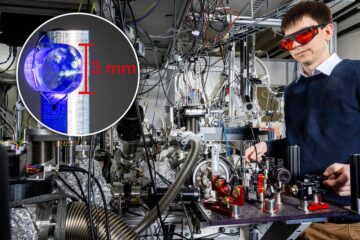Grid Technology for Product Development and Production Process Design (SIMDAT)

Grid Technology for Product Development and Production Process Design (SIMDAT) – one of 12 EU-funded Research Projects aiming at taking Big Science Processing Power to Business and Citizens
The European Commission will provide a total of Euro 52 million to twelve European research projects, that together aim to bring „Grid“ networked computing out of research labs and into industry. Grid tools are seen as key to boosting business competitiveness and helping creation of new markets and services by giving everyone access to the vast computing power and knowledge resources that up to now have only been available to the biggest companies and research centres. By enabling users to monitor and model everything from climate change to how cars behave in collisions, they will also help to improve the quality of life.
Collectively the 12 projects’ goals reflect EU Grid research policy of combining „technology push“ (developing underlying technologies and interoperability standards), with „application pull“ (developing the enabling technologies needed for real-world applications, such as modelling, simulation, data mining and collaborative working tools). The funding for the projects comes from the EU’s sixth research Framework Programme (FP6).
One of the 12 projects just launched is the SIMDAT project which aims to test and enhance grid technology for product development and production process design as well as to develop federated versions of problem-solving environments by leveraging enhanced Grid services. Further objectives are to exploit data grids as a basis for distributed knowledge discovery as well as to promote de facto standards for these enhanced Grid technologies across a range of disciplines and sectors. A pan-European consortium has been assembled to achieve these important goals. Partners include Fraunhofer-Institute SCAI and Fraunhofer-Institute AIS, EADS Centre Commun de Recherche, ESI Group, MSC.Software GmbH, Lion Bioscience Limited, BAE SYSTEMS (Operations) Limited, AUDI AG, InforSense UK Ltd., Intel GmbH, NEC Europe Ltd., Renault, IT Innovation, The University of Southampton (School of Engineering Sciences), LMS International N.V., Deutscher Wetterdienst, European Centre for Medium-Range Weather Forecasts, Met Office, Météo-France, ontoprise GmbH, IBM United Kingdom Limited, IDESTYLE Technologies, Université Libre de Bruxelles, Universität Karlsruhe (TH), GlaxoSmithKline Research and Development Ltd., EUMETSAT, ORACLE Deutschland GmbH.
„European Grid Technology Days“, a public launch event for the EU-funded Grid projects, is being hosted by the European Commission on 15 September 2004. From the European Commission F. Colasanti, Director General of Information Society will be speaking at the event along with senior figures from European industry and research including Dr. Isidoro Padilla, CEO, Telefónica I+D; Dr. Joachim Schaper, Vice President of SAP; Dr. Steve Sim; General Manager Research, British Telecom; Dr. Gilles Kahn, President and CEO, INRIA France and Dr. John Taylor OBE, ex-Director General UK Research Councils. These and other high level participants will be available for journalists to discuss with.
For further information about SIMDAT please contact:
Clemens-August-Thole
Fraunhofer-Institute for Algorithms
and Scientific Computing (SCAI)
Schloss Birlinghoven
D-53754 Sankt Augustin
phone: +49 224114-2739
fax: +49 224114-2181
Media Contact
Weitere Informationen:
http://www.nextgrid.org/events/1509.html http://www.cordis.lu/ist/grids/ http://www.scai.fraunhofer.deAlle Nachrichten aus der Kategorie: Energie und Elektrotechnik
Dieser Fachbereich umfasst die Erzeugung, Übertragung und Umformung von Energie, die Effizienz von Energieerzeugung, Energieumwandlung, Energietransport und letztlich die Energienutzung.
Der innovations-report bietet Ihnen hierzu interessante Berichte und Artikel, unter anderem zu den Teilbereichen: Windenergie, Brennstoffzellen, Sonnenenergie, Erdwärme, Erdöl, Gas, Atomtechnik, Alternative Energie, Energieeinsparung, Fusionstechnologie, Wasserstofftechnik und Supraleittechnik.
Neueste Beiträge

Atomkern mit Laserlicht angeregt
Dieser lange erhoffte Durchbruch ermöglicht neuartige Atomuhren und öffnet die Tür zur Beantwortung fundamentaler Fragen der Physik. Forschenden ist ein herausragender Quantensprung gelungen – sprichwörtlich und ganz real: Nach jahrzehntelanger…

Wie das Immunsystem von harmlosen Partikeln lernt
Unsere Lunge ist täglich den unterschiedlichsten Partikeln ausgesetzt – ungefährlichen genauso wie krankmachenden. Mit jedem Erreger passt das Immunsystem seine Antwort an. Selbst harmlose Partikel tragen dazu bei, die Immunantwort…

Forschende nutzen ChatGPT für Choreographien mit Flugrobotern
Robotik und ChatGPT miteinander verbinden… Prof. Angela Schoellig von der Technischen Universität München (TUM) hat gezeigt, dass Large Language Models in der Robotik sicher eingesetzt werden können. ChatGPT entwickelt Choreographien…





















